Air pollution is a real thing. And the world can already see what damages it is causing.
Air pollution has caused a drastic increase in the number of Asthma patients.
Air pollution has caused acid rain which damages the ecology.
And air pollution is the main contributor to global warming.
So air pollution is a real thing and we need to act today.
That is what IMO must have said to itself in the year 1997 when it adopted Annex VI to the Marpol convention.
Air pollution, Global warming, acid rain, ozone depletion. No matter how big words these may seem, it is not that tough to bring our contribution in preventing these.
All we have to do is comply with the Annex VI of the Marpol. The first step towards compliance is the knowledge of what is expected from we seafarers.
In this post, I will discuss 10 things we ought to know about Marpol Annex VI.
Let us start.
1. SOx
This is one of the components that Annex VI aims to reduce from burning of ship’s fuel.
SOx is the short form of Sulpher oxides and the most common sulphur oxides gases are Sulpher dioxide (SO2) and sulphur trioxide (SO3).
In the third IMO Green house gases study, MEPC noticed that shipping contributes to the 13% of the total SOx emissions.
When averaged for the years 2007 to 2012, a total of 11.3 million tonnes of SOx gases were emitted from the ships.
The question is, how SOx emission from the shipping can be reduced.
And there are only two possible ways
- Burn less or no fuel
- Use fuel containing as low sulphur as possible
Though optimizing speed for better fuel efficiency is encouraged by all the stakeholder, it is something that cannot be enforced upon.
The thing that can be enforced is the use of low sulphur fuel on board ships.
MARPOL Annex VI does exactly that.
As per regulation 14 of the MARPOL annex VI
The sulphur content of any fuel oil used on board ships shall not exceed the following limits:
- 4.50% m/m prior to 1 January 2012;
- 3.50% m/m on and after 1 January 2012; and
- 0.50% m/m on and after 1 January 2020.
Of course, the first limit of 4.5% m/m is no more valid as we are already past 1 January 2012 deadline.
These limits are reduced when the ship is operating within an emission control area.
- 1.50% m/m prior to 1 July 2010; and
- 1.00% m/m on and after 1 July 2010;
- 0.10% m/m on and after 1 January 2015
Fuel Changeover procedures
When a ship is going to emission control area, it needs to change the fuel consumption to the low sulphur fuel as required.
This change over requires that before entering into the ECA, all the components of the fuel system must be using low sulphur fuel.
These components include
- Main engine
- Boilers
- Associated Fuel oil pumps
- Associated pipelines
Ship’s staff should be aware of the time required for this change over and how this fuel change over is to be executed.
Marpol Annex VI requires that
Each ship shall carry a written procedure showing how the fuel oil changeover is to be done. This shall allow sufficient time for the fuel oil service system to be fully flushed of all fuel oils exceeding the applicable sulphur content prior to entry into an emission control area.
Marpol annex VI also requires that record is maintained for all fuel oil change-over carried out before entry into ECA and after exit from ECA.
The record must contain at least the following information
- Tank wise Soundings and volume of low sulphur fuel oil
- Date, time and position fuel change over started
- Date, time and position fuel change over completed
- Date, time and position of entry into ECA
- Date, time and position on exit from ECA
2. NOx
As with the SOx, NOx too is the major air pollutant that is seriously harmful.
In the third IMO Green house gases study, MEPC noticed that shipping contributes to the 15% of the total NOx emissions.
But unlike SOx, NOx gases are not generated by burning the fuel but by the process of burning the fuel.
NOx gases are produced from the reaction of nitrogen and oxygen gases present in the air during the combustion process.
This reaction takes place at the high temperatures which the combustion of fuel in the engine provides.
So how the NOx can be reduced from the ship’s diesel engine?
It can only be reduced by the design of the diesel engine.
Well, I do not have a technical bone in my body so I won’t go into detail of what design changes can produce lesser NOx.
But for the purpose of understanding the requirements of Annex VI, we just need to know that NOx emission can be reduced by the better design of the ship’s engine.
Now there are certain NOx emission levels set by the MARPOL Annex VI. The requirements of these emission levels are divided into three tiers.
- Tier I
- Tier II
- Tier III
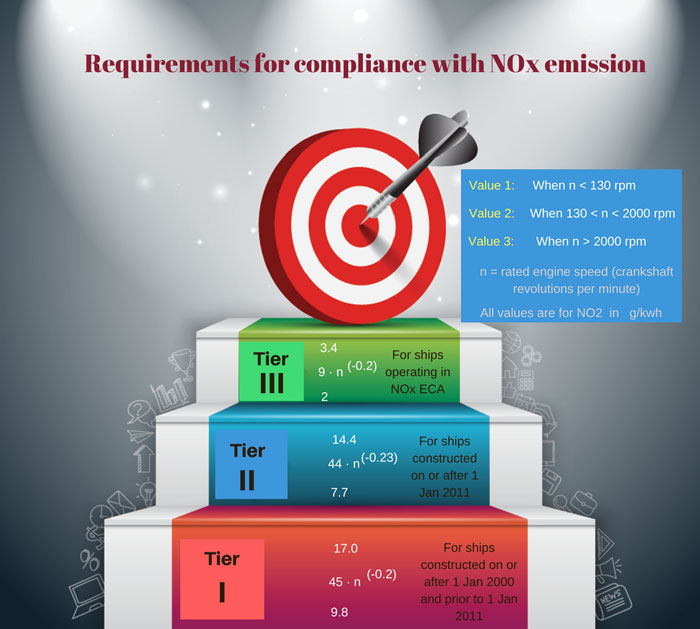
A Marine diesel engine that is installed on a ship constructed on or after 1 January 2000 and prior to 1 January 2011 fall under Tier I.
A Marine diesel engine that is installed on a ship constructed on or after 1 January 2011 fall under Tier II.
Tier III requirements are
- for the ships operating in an emission control area designated for Tier III NOx control
- for the ship is constructed on or after 1 January 2016 and is operating in the North American Emission Control Area or the United States Caribbean Sea Emission Control Area
Compliance with NOx emission
We have so far seen what NOx is and what Marpol Annex VI requires in terms of NOx emissions.
But the question is, how do we know if the amount of NOx gases emitted by the ship’s engine is within the required levels?
How do we prove the compliance with required NOx standards on board?
Compliance with NOx emission involves few parameters and records. Let us discuss this one by one.
Engine International Air Pollution Prevention Certificate (EIAPP)
Hearing about this certificate for the first time? Get your hands on this certificate next time you are on board.
EIAPP certificate must be present on board. And this certificate needs to be for each of the diesel engines more than 130KW on board.
Why 130KW?
Because the NOx requirements are applicable for diesel engines more than 13oKW power.
Now say, the ship is fitted with one main engine and three auxiliary engines (generators). There needs to be EIAPP certificate for all these.
Now, what does EIAPP certificate certify?
EIAPP certificate is issued after the engine is found to be complying with the NOx emission requirements during the pre-certification survey.
The pre-certification means the survey done before fitting the engine on board the ship.
Having an EIAPP certificate on board shows that the engine fitted on board was complying with the NOx parameters and an engine of correct specifications was fitted on board.
International Air pollution prevention certificate (IAPP)
After the engines are fitted on the ship, the test is again done on the engines for compliance with the NOx criteria.
This test is required because when the engine is fitted on board ships, some changes/modifications might have been done on the engines.
This test proves that the engine still complies with the NOx requirements even after fitting on the ship.
If the engines are found to in compliance with the NOx criteria of annex VI, International air pollution prevention certificate is issued to the ship.
NOx on board Verification
Having EIAPP and AIPP certificates on board proves that the engine of the correct specification is fitted on board.
It proves that when the engine was fitted on board, the NOx emissions from the engine were within limits and as required by MARPOL annex VI.
But how can we prove that even after 10 or 20 years in operation, the ship’s engines still comply with these requirements?
There are three ways in which ship can prove that it still complies with the NOx requirements.
- Engine Parameter Check method
- Simplified Measurement method
- Direct Measurement and Monitoring method
The method that the ship is certified to use for on board verification of NOx is specified in the EIAPP certificate of the engine.
And the procedure to verify on board compliance (and using the certified method) is provided in the NOx technical file that accompany the EIAPP certificate of the engine.
The “simplified measurement” and “Direct measurement and monitoring” methods are based on measuring the NOx emissions from the engine.
Frankly, I seldom see these two methods used for NOx on board verification.
What I have mostly seen is the Engine parameter check method used on the ships for NOx on board verification. May be because of the simple principle it is based upon.
Engine parameter check method
This method is based on the principle that if the engine complied with the NOx parameters at the time it was fitted on board, it should continue to comply if there are no modifications/adjustment made to the engine.
This is really a simple and logical thing to say.
And as there are absolutely no extra costs involved to use this method, this method is most common among ship owners.
So there are few things that are required from this method that we must know.
- We must know the engine parts that contribute to the NOx emission. Modification and adjustments of these parts must be as per the Maker’s guidelines.
- If any of these spare parts of the engine need to be changed, it must be changed with the original part supplied by the maker.
- Any adjustments made to these parts must be within the range specified by the maker of the engine.
- A record must be kept of all the replacements of the spare parts and all the adjustments made to these parts.
Durning annual, intermediate and renewal survey of the Air pollution prevention certificate, these records, and engine parameters are checked by the class surveyor.
The international air pollution prevention certificate is endorsed or renewed on the basis of these verifications by the class surveyor.
NOx Technical file
So I said for the NOx compliance with engine parameter check method, the parameters of the engines need to be same throughout the life of the engine.
But where can we find these parameters for the engines fitted on board?
Where can we find the list of components that affect the NOx emission from the engine?
These all parameters are there in the NOx technical file.
NOx Technical File is a record containing all details of parameters, including components and settings of an engine, which may influence the NOx emission of the engine.
So there is one NOx technical file for each engine for which an
EIAPP certificate is issued.
NOx technical file contains information about
- identification of those components, settings and operating values of the engine which influences its NOx emissions
- Allowable adjustments on the engine
- on board NOx verification procedures to verify compliance with the NOx emission limits during on board verification surveys
Conclusion
Marpol annex VI requires that ship must comply with the SOx and NOx emission requirements set out in the convention.
Seafarers must be aware of how to ensure compliance with SOx and NOx emissions.
Compliance with SOx is simple. Just use the fuel with sulphur content as per the limitation set for the area the ship is trading. Ship staff must have the procedures to change over from high sulphur to low sulphur fuels.
The compliance with NOx is ensured if
- the ship has EIAPP certificate for each of the diesel engine fitted on board
- The ship has a valid Air pollution prevention certificate
- All the components of the engine are maintained as per the NOx technical file provided on board for each diesel engine.
When we do so, not only we can sleep peacefully, we can also take pride for contributing towards making the earth a better place to live.
Share this:

About Capt Rajeev Jassal
Capt. Rajeev Jassal has sailed for over 24 years mainly on crude oil, product and chemical tankers. He holds MBA in shipping & Logistics degree from London. He has done extensive research on quantitatively measuring Safety culture onboard and safety climate ashore which he believes is the most important element for safer shipping.
Search Blog
58 Comments


Sir, could you clarify on the following: 1) what does % m/m mean? 2) the IMO website states different dates for special areas with regards to "date of entry into force" and "in effect from".

%m/m is the percentage of mass per mass. So if 1 gram of sulphur is present in 1 kg (1000 grams) of oil, it will be 0.1 % m/m. I leave the maths up to you...

Finally understood Annex VI completely....Thanks a tonne

Thanks Farhan...

finally i got it man , thanks a ton man

Thanks...

Very eloquent in explaining !

Thanks Gokul...

Hi Mr.Jassal, really u have so nicely & so easily make us understood.Thanks for ur contribution.The fundamental was missing from all other books i read.Preparing for my orals now; at least in this section i would be more comfortably than the surveyor i think.

Glad you found it useful Arunava...

Amazing work in a simple manner.Keep the good work going sir.

Glad you liked it Siddharth...

Thank you for the explanation. I have a further query, if there is no approved NOX spare onboard then what will be the correct course of action ?

I read many times annex vi but first time covered full thank you very much Capt. Rajeev

Its very clear to me now.tnks.

sir hats off to you.. before i thoght EIAPP AND IAPP WOULD BE THE SAME..BUT NOW I KNW...THANK YOU SIR..

I had searched Google about nox, sox...earlier but there was only 9 ways to reduce this 5 ways to increase that and so on... Finally found your article! Nicely explained crucial points.

thank u sir. explained in simple language. finally understood sox and nox.

I'm very appreciate You for Yrs detailed and edifying lecture.

Good job....thank you..sir...

It is required to be updated every engine maintenance job done all jobs under Technical file section D? replace/overhaul.

Sir please am carrying out a research on pollution from engine exhaust, and I will need your help. This is my email- etinyenejohnson@gmail.com Thanks

Thanks for the explanation, it was simple and easy to understand. Very helpful read.

For SOx controlling an alternative is "Exhaust Gas Cleaning"

kindly explain how to accomplish nox record, specially the difference of ID number and parts number portions for FO inj. nozzle. tnx.

thank you for the very useful information. my question is, is there a form which must be filled up just in case you renew or check a specific part of an engine? example nozzles,plunger and barrel. because recently we were inspected by an port state and he is looking for a form which must be filled up when i change a nozzle of a generator engine.

no comparison to this extremely easy way of explanation. I worry to wonder if you ever stopped writing articles. Please never do. In my opinion seafarer fraternity has never seen any such source of bright knowledge anywhere in books or internet; even the teachers. As a fellow seafarer, I am ready to extend any support whatsoever , should you require in this process of sharing your knowledge. You undoubtedly put a lot of efforts in gathering the quality of material that we are able to access with just single easy click. Thanks a lot captain

Thanks sir

thank you very much sir...

Outstanding information!

Well said sir. Thanks so much for such brilliant explanation. It's really essential that we, seafarers, have such knowledge in order to save our universe!!!

Thanks so much sir, for this good information. Its very important for us, seafarers, to have a good knowledge about air pollution in order to save the world.

What about frequency of verification, monthly?annual?need your wise suggestion.

Very nicely explained sir

Many thanks for your detailed explanation!

Kindly explain HSSC and ESP

thanks a ton for explaining this nox technical file in such a way .

It clearly and easily understood by everyone. Thanks for the explanation http://humatech.co.kr/index.php?lan=eng

Thanks so much sir, for this good information.

Nicely explained crucial points. air quality monitor

Excellent explanation Great job sir!!!!

"You can only buy replacement parts from the original supplier" Whilst engine builders may try to convince you of this, it is simply untrue. The engine’s NOx technical file must be supplied to the vessel upon delivery and this technical document gives all the parameters for all NOx influencing components and the requirements stipulated must be met irrespective of supplier in order to renew your environmental certificate. But In order for the class society to reissue the environmental certificate for the vessel, a surveyor needs to check all components and settings using the NOx technical file as reference. This process and the supporting documentation must be supplied to them irrespective of where the replacement is purchased.

sir, your Simple way of explaining clears so many doubts.

Very nicely presented.

sir please write blog on MLC and STCW

Great Work Sir....who says you do not have technical bone.....I am an engineer....You have very good knowledge which many engineers is not having....keep doing good work sir...

Very nice

Hi sir...your contents are great, helping me a lot for class 2 exam now ...keep do more...thank you

Very well explained nox n sox..

Hii Sir, Your blog is very useful. Could you please share the procedures for conducting Nox spot test in SCR onboard for Annual survey to renew IAPP Certificate.

+27732318372 Bring Back Lost Lover in 24 hours Specialist,www.strongspellcaster.us.com @in THE USA UK UAE, SINGAPORE AUSTRALIA HONG KONG best love spell caster online, bring back lost love 24 hours, Bring back Lost Love spells, candle love spells to bring back a lover, love spell casters that work immediately,love spells, love spells that work instantly, how to bring back lost lover 24 hours, how to cast a love spell, how to cast a love spell on my ex, how to cast a love spell that works, i need a love spell, lost love spell caster in Johannesburg, lost love spells Australia, lost love spells USA, love spell caster Canada, love spell caster in Johannesburg, love spell caster in South Africa, love spell caster London, love spell caster near me, love spell caster online, love spell caster UK, love spell caster USA, love spell casters, love spells in London, love spells in Stockholm, love spells in Sweden, Love spells that work, love spells that work for real, love spells that work instantly with proof, love spells that work overnight, mantra to bring back lost love 24 hours, powerful lost love spells, powerful love spell casters, real powerful love spells, simple spells to bring back a lover UAE, DUABI, CANADA, ENGLAND,united kingdom,SINGAPORE, NEWZEALAND, GERMANY, ITALY, MALASIYA,Abu dhabi London IN New York kuwait SouthAfrica,South Korea,Thailand Qatar,England,Queens California HongKong Japan Brazil Switzerland colombia Saudi Arabia maxcio city Howland Island CANADA Alberta. Vancouver Brampton British Columbia. Manitoba. New Brunswick. Newfoundland and Labrador. Nova Scotia. Ontario.Victoria Prince Edward Island Europe United States KUWAIT ITALY, MALASIYA Vashikaran Specialist IN United Kingdom Aberdeen , Birmingham , Brighton , Bristol , Cambridge , Devon ,East Midlands , Eastanglia , Edinburgh , Glasgow , Hampshire , Leeds , Liverpool , London , Manchester , Newcastle , Oxford , Sheffield , Wales email. info@strongspellcaster.us.com or you can visit https://www.strongspellcaster.us.com

Technumus is the most informative and knowledge increasing webisite. please follow visit and suppot us.WHAT IS THE PARAMETER OF INTEREST IN STATISTIC

Technumus is the most informative and knowledge increasing webisite. please follow visit and suppot us.WHAT IS THE PARAMETER OF INTEREST IN STATISTIC

Excellent explanation Sir. Before reading this article this subject was like Greek to me. Now I found it simple. Thank you very much

If measurement and monitoring methods are not mandatory, and not used, is it therefore impossible to prove that even after 10 or 20 years in operation, the ship’s engines still comply with these requirements?
Leave Comment
More things to do on myseatime

MySeaTime Blogs
Learn the difficult concepts of sailing described in a easy and story-telling way. These detailed and well researched articles provides value reading for all ranks.

Seafarers Question Answers
Ask or answer a question on this forum. Knowledge dies if it remains in our head. Share your knowledge by writing answers to the question

MySeaTime Podcast
This podcast on the maritime matters will provide value to the listeners. Short, crisp and full of value. Stay tuned for this section.

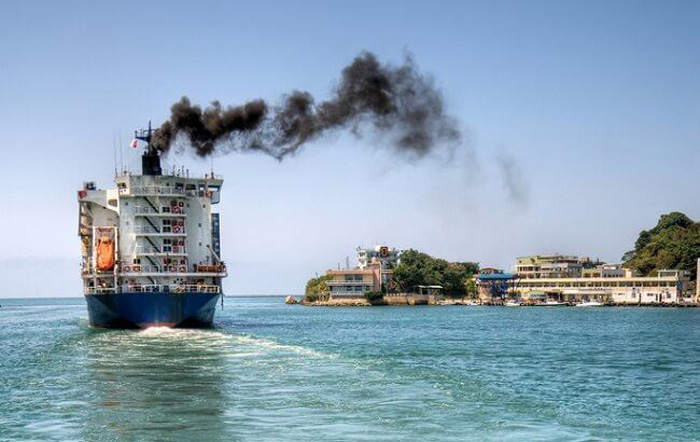
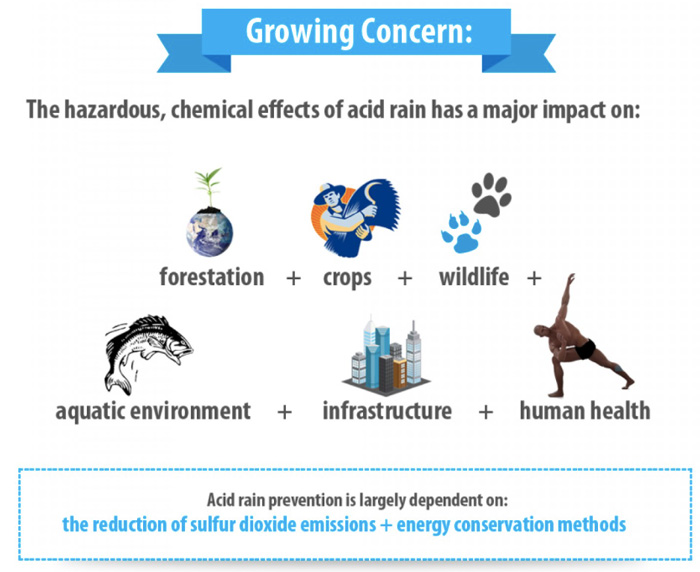
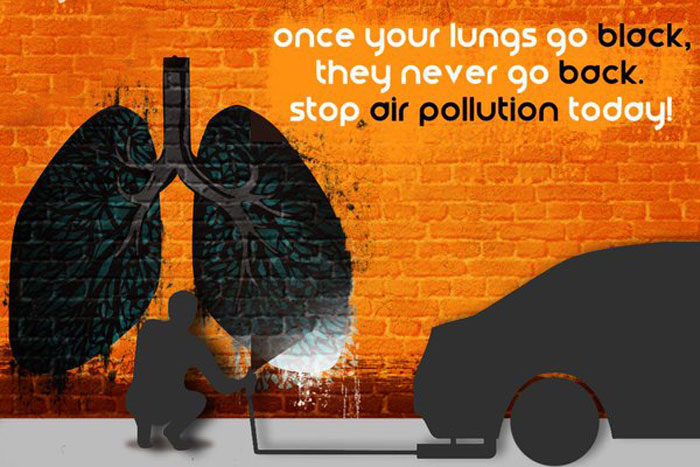
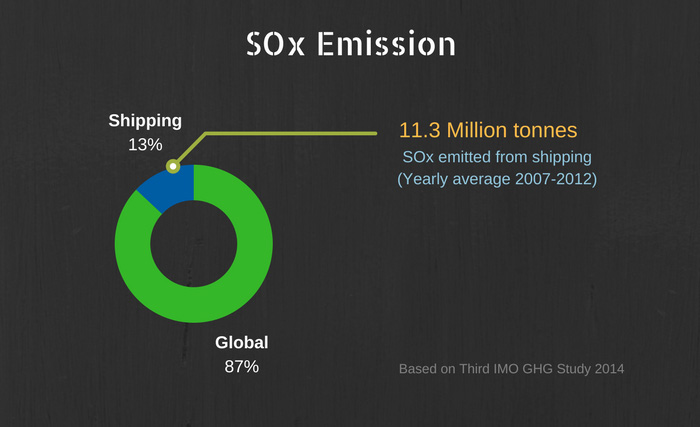
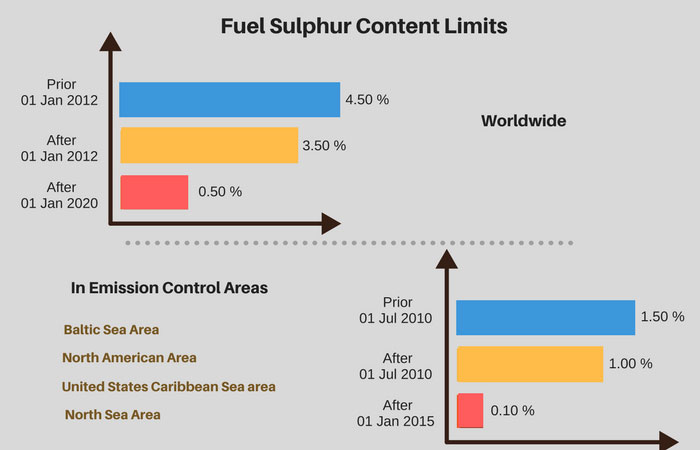
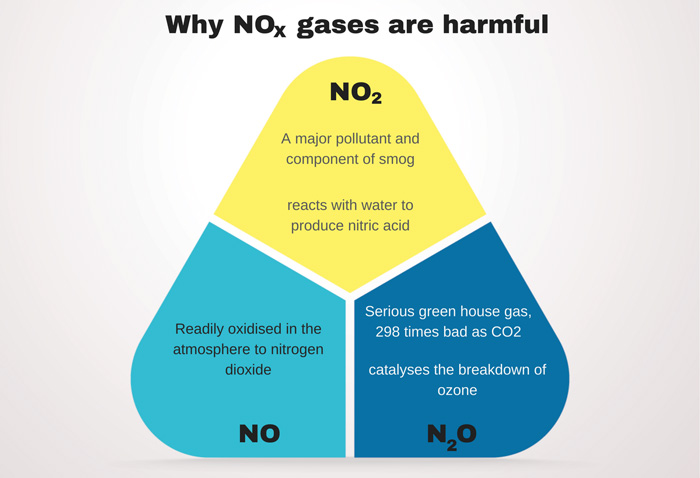
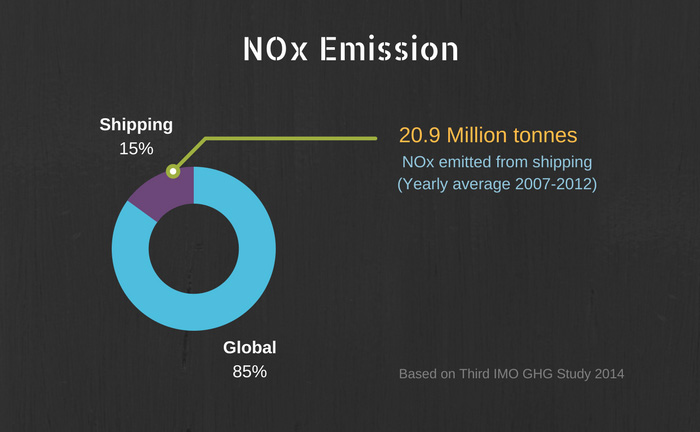
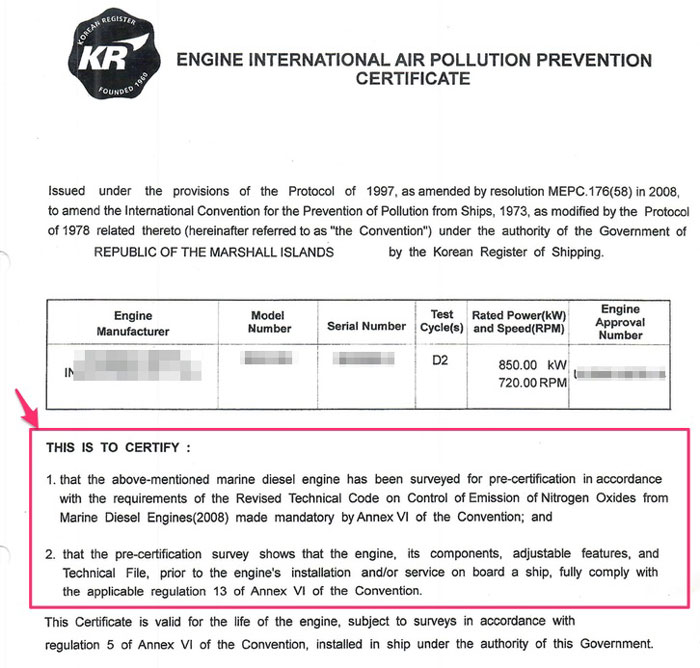
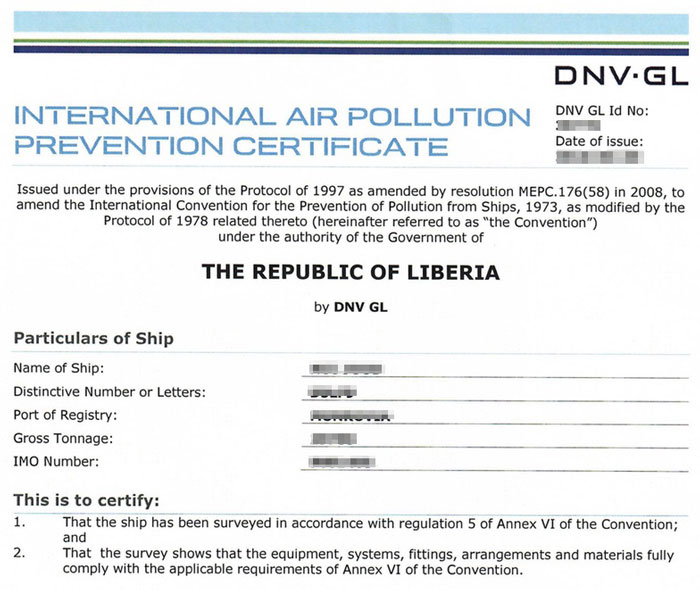
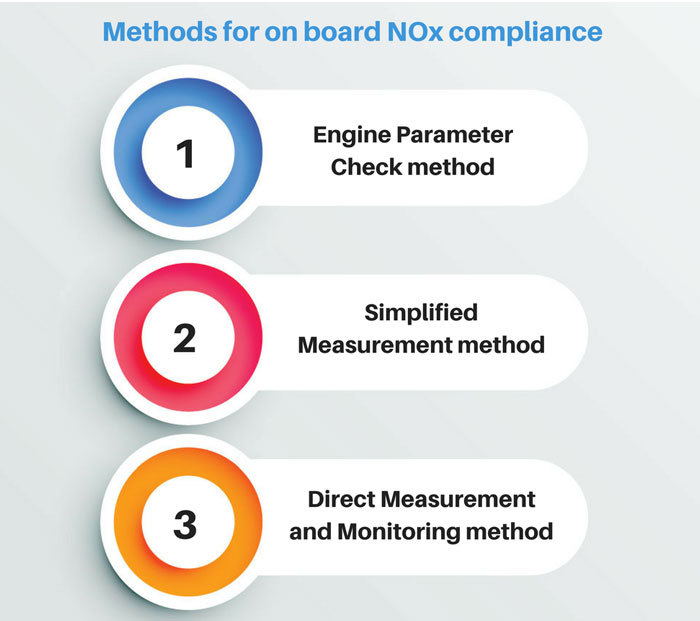
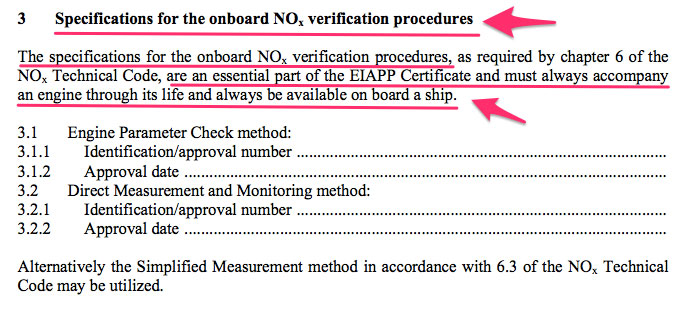
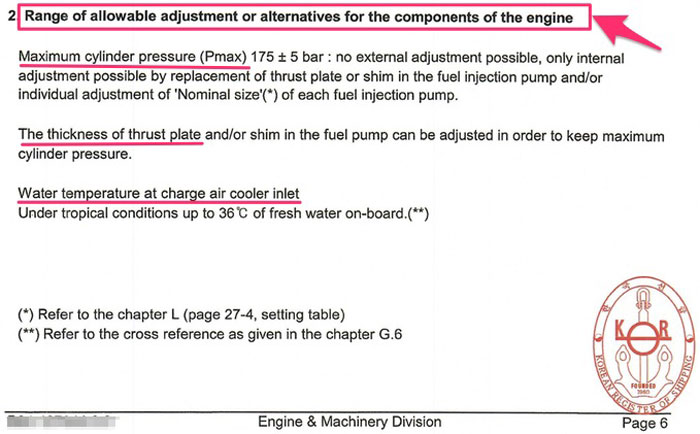
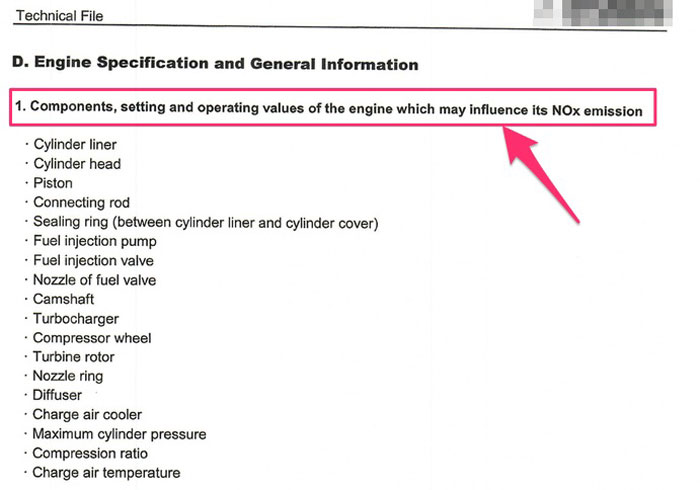
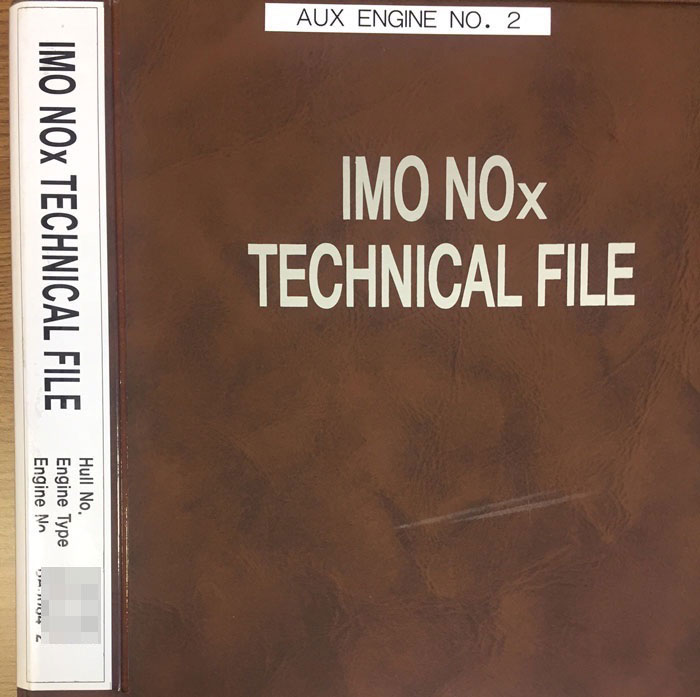
Nicely explained sir.
Thanks Rahul...
Sir please make a blog about oil discharging procedures as per marpol